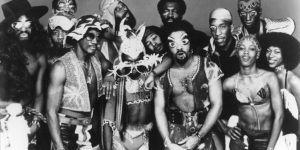CRAM SESSION: An intro to fearless alt-rocker PJ Harvey
by Jeremy Curry
March 22, 2016
A look back at the boundary pushing PJ Harvey before the release of her new album, 'The Hope Six Demolition Project.'
It seems like it has been too long since PJ Harvey’s excellent 2011 album Let England Shake, a departure from her previous records which focused on many personal issues, including love and religion, often with some sarcasm and humour thrown into the mix. Let England Shake turned Harvey’s aim towards the politics and relationships surrounding her homeland of the UK, specifically during the war.
Harvey’s latest album, The Hope Six Demolition Project, is still focused on politics and the imagery of places she has visited since her last release such as the U.S., Afghanistan, and Kosovo. Her recent single “The Community of Hope” has garnered a lot of negative criticism from politicians in Washington, D.C. with its depiction of the city’s underdeveloped neighbourhood, Ward 7. Before its release, this album has already sparked some intense and important conversation.
As one of the most prolific singer-songwriters of the ’90s, Harvey’s voice has always stood out, and she continues to be uniquely fantastic. She is a major influence on many musicians, and for good reason. The sound of her albums has changed over the years, while dabbling in different genres from the minimal ballads of 2007’s White Chalk to the rip roarin’ wonk-rock of 2004’s Uh Huh Her. Always pushing the boundaries of whatever was safe at the time, she has consistently made it her own. Harvey’s catalogue offers a lot to go through, but here is a list of choice albums to familiarize yourself with her music.
Dry (1992)
Harvey’s first full-length Dry already broke the mould of typically popular genres at the time. With guitars that sound as if the notes could scatter all over the place at any moment, it’s held together by the thread of Harvey belting out intense vocals like her life is depending on it. This ambitious debut is a great introduction to her music. Some of the record does sound very much like what you would expect from typical ’90s alt-rock, and we aren’t talking about something form the outer limits here. This is a rock record first and foremost, with some sly punk ‘tude to spice things up.
Rid of Me (1993)
One year later came, Harvey release the stellar Rid of Me. This record amped everything up, and sounded much more abrasive and well-rounded than her previous effort. The kick-in-the-gut approach to heavy jams is really felt on this album, straight from the beginning. The whisper-to-shouting opening title track really does the trick, paving the way for how the rest of the album is going to sound. There isn’t a dull moment on the whole thing. Harvey’s lyrics are powerful and personal, which is one of her strong suits. Weaving a story into song with a strong personal touch and making it sound good is a difficult thing. Rid of Me is a real rager, with vocal creaks, yelps, and yowls along with chunky riffs.
To Bring You My Love (1995)
PJ Harvey’s first two records were described as blues-punk, which sounds kind of silly, but the opening guitar riffs on her third album might fit into that category. It sounds like a sweaty desert guitar jamming in the dunes, whatever that means. A minimal opener with maximal vocals, Harvey belts it out like nobody else. Going from hushed whispers to straight howlers she never distorts her lyrics. Harvey sounds passionate about what she has to sing, and that makes the listener want to hang on each and every word. At this point, her lyrics were being compared to an American gothic style in the tradition of Tom Waits and Nick Cave. Her vocal style sometimes is reminiscent of Cave’s, and they first teamed up for the song “Henry Lee” on his 1996 album Murder Ballads.
Stories from the City, Stories from the Sea (2000)
Inspired by her time living in New York City as well as in the English countryside, this album might be Harvey’s most popular, and possibly the most accessible. It definitely feels a lot calmer than her previous releases. You could almost be comfortable putting this disc in your mom’s car. Not to say accessibility isn’t cool. It can be, and it is here. “This Mess We’re In” is a wonderful duet with famous bleep bloop master Thom Yorke, before he started making music for chill-out rooms. Their vocal trade-off is beautiful, and would be the focal point of the album, if songs like “Kamikaze” weren’t around to throw all that accessibility to the side. The falsetto vocals are the big hit here. Once “Horses in My Dreams” comes on, it feels like the party is over, with you and your friends left to catch your breath in a messy living room. It’s an emotional, heartbreaking sound, helping the album stand out.
Uh Huh Her (2004)
This album evokes a fun “fuck off” to whatever kind of particular sound people were expecting from Harvey at this point. Where the last album felt like it was the most accessible, this one strays from that, and goes straight for a kick in the balls. Ouch! There are crazy rippers like “Who the Fuck?” as well as dirty fat blues punkers like the opening track, “The Life and Death of Mr. Badmouth”. There are some pretty heavy moments on here, but the arrangements remain sparse. It delivers a similar feeling to Harvey’s debut, with cleaner production. The very minimal “Shame” is overshadowed by her excellent vocals, showing that no matter how little emphasis you put on instruments, her music will always yield maximum results with Harvey’s singing style. Some of the tracks even feel like precursors to future offerings. A taste test.
White Chalk (2007)
Where Uh Huh Her was a wild romp, this is a stroll through a graveyard. Gone are the punkish blow-outs for a complete album of eerie ballads. The vocals are still wild and full of emotion, but there is now more focus on darkness, loneliness, and all of the uplifting stuff Harvey has come to celebrate. White Chalk is a beautiful album, which feels much too short, despite the supernatural subject matter. The guitar is replaced by the piano as the main instrument on most of the tracks, and it is fitting for an album that could be playing in a parlour where Ichabod Crane is having a drink. This record sounds intimate, sad, and without any pretension. It is one of the most serious albums in Harvey’s catalogue, and you should give it your full attention. It’s a great thing to listen to on a cold, dark night.
Let England Shake (2011)
As mentioned in the introduction, this is Harvey’s album focused on politics and war in England. She touches on World War I, as well as the Turkish battleground of Gallipoli for some of the songs, which sometimes feel contradictory in terms of the sound of the music and the lyrical content. A bugle horn honks triumphantly before Harvey sings that the glorious country is plowed by tanks and feet marching. The song is referring to the military and the ongoing Afghan war. Many of these songs are similar, and tell some pretty devastating stories. Let England Shake is a beautiful, depressing album that really hits hard. Political messages in music often fail to resonate without being based on a basic principle or pandering to the crowd. This is nothing like those songs, with every moment crafted in a passionate and incredibly smart fashion. Let England Shake is an album that should be revisited for years to come.





